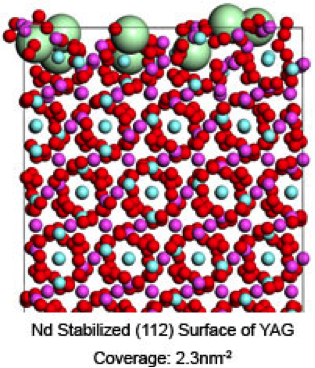Contact: P. Bowen
Yttrium Aluminium Garnet (YAG) lasers have seen a big success in recent years. Often Neodymium (Nd) is used as a luminescent dopant element. The quantity of Nd in the structure determines the laser power. In the bulk of a traditional monocrystal around 1.4 at. % of Nd can be incorporated. In addition to being cheaper in production and often presenting a less defective crystalline structure, polycrystalline YAG can incorporate more dopant atoms and if transparent ceramics can be fabricated can result in higher power lasers. Following the successful atomistic simulation of segregation of Nd to surfaces [1] and grain boundaries [2] in YAG – we have used this information in a microstructural model to predict the optimum dopant concentration versus grain size for Nd:YAG laser ceramics [3]– linking atomistic simulations to macroscopic ceramic properties.
A study on Nd segregation to (110), (112) surfaces (experimentally found to be morphology dominating) as well as (100) and (111) surfaces (likely to have low surface energies) of YAG [1] showed that the equilibrium morphology in vacuum consists of (100) and (112) surfaces. The segregation to twin grain boundaries made up from the above surfaces showed that generally interfaces with a high interfacial energy (e.g. (111), and (100)) show a higher trend for segregation.[2]. Using space-filling rhombic dodecahedra a microstructural model incorporating grain boundaries and grain size was developed. The grain boundaries can be assumed to be made up of either only the lowest energy terminations of each type of grain boundary (equilibrium microstructure) or of all of them (rapid sintering microstructures. e.g. spark plasma sintering).[3]. Then using an optical model taking into account the change in refractive index of the grain boundary as a function of the Nd segregation the transparency vs. amount of Nd in the bulk of the ceramic grains (laser power) could be evaluated for different grain sizes and dopant concentrations. It was found that while small grain sizes enhance transparency, luminescence is reduced, resulting in a trade-off to achieve optimum laser performance. These effects are linked to ceramic production route by considering different sintering routes. This improved insight into the microstructural effects of Nd:YAG ceramics on laser performance will allow a more targeted experimental optimization of this new class of laser materials. Basically at grain sizes lower than 500nm too much Nd is lost to grain bounbary segegation leading to concentration quenching. For grain sizes > 10 μm transprency is lost because of grain boundary refractive index changes due to Nd Segregation. The optimum grain sizeshould prbably be in the region of 1-2 microns.
 |
 |
| Atomistic simulation of Nd segregation to a (112) surface – the Nd ions (grey) are shown overscale for clarity (red-oxygen , pink – Yttrium, blue- aluminium). | Amount of Nd found in Grain Boundaries (GB) as a function of grain size (Full lines) – predicted from a combination of th e atomistic simulations [2] and microstructural model based on space filling rhombic dodecahedra [3]. Dashed lines = amount of Nd depleted from the bulk of the ceramic grains (loss of luminescence and power due to concentration quenching at the grain boundaries). |
Publications
[1] Aschauer U., Bowen P., Parker S.C., Atomistic modeling study of surface segregation in Nd : YAG, Journal of the American Ceramic Society, 89(12), (2006), 3812-6
(Link to article)
[2] Aschauer U., Bowen P., Parker S.C., Surface and Mirror Twin Grain Boundary Segregation in Nd:YAG: An Atomistic Simulation Study, Journal of the American Ceramic Society, 91(8), (2008), 2698-705,
(Link to article)
[3] Aschauer U., Bowen P., Theoretical assessment of Nd:YAG ceramic laser performance by microstructural and optical modeling, Journal of the American Ceramic Society, 93(3), (2010), 814-820, (Link to article)